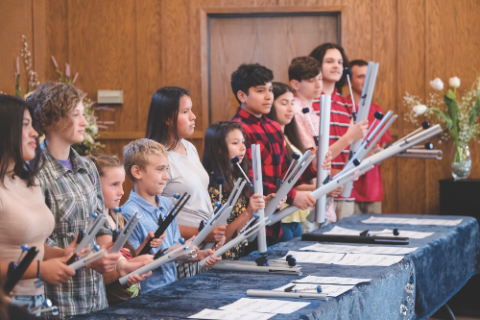To Adventists living in the twenty-first century it may seem that Christian education has been central to their church from its inception. That, however, is far from the truth. Formal education, in fact, was the last major institutional development within the denomination. The establishment of a rigorous publishing program in 1849, a centralized church organization in 1863, and a health-care outreach in 1866 had all preceded it. By way of contrast, the Adventist Church established its first school in 1872 (28 years after the Millerite disappointment) and did not have a widespread elementary system until nearly 1900.
While the tardy development of Adventist schooling might come as a surprise to present-day Adventists, it had its roots in the very logic of their spiritual forebears, who, above everything else, believed in the immediate return of Jesus. Religious groups focusing on the nearness of the end of the world have generally not felt much need for educating their children beyond the essential concepts of their religious persuasion and the skills needed to earn a living in the short interim.
That was true of the early Christian church, and it was also the case of early Seventh-day Adventism. Why send children to school, so the logic runs, if the world is soon to end and they will never grow up to use their hard-earned learning? Some might interpret providing a formal education for one's children as a lack of faith in the immediacy of the Advent. Such attitudes were widespread among Seventh-day Adventists.
As late as 1862 a church member wrote James White asking if it was “right and consistent for us who believe with all our hearts in the immediate coming of the Lord, to seek to give our children an education? If so, should we send them to a district school, where they learn twice as much evil as good?"
White replied that "the fact that Christ is very soon coming is no reason why the mind should not be improved. A well-disciplined and informed mind can best receive and cherish the sublime truths of the Second Advent."
With that statement he set the stage for the development of an Adventist system of schooling.
A flash of concern for Adventist education occurred during the 1850s. James White wrote that you couldn’t just take children from school and “let them run at large with the children in the streets. 'An empty brain is the devil's workshop.'"
Attempts at Adventist schooling sprang up in such places as Buck's Bridge, New York, and Battle Creek, Michigan. But all failed. Thoroughly discouraged on the topic of schooling, James wrote in 1861 that "we have had a thorough trial of a school at Battle Creek, under most favorable circumstances, and have given up."
For another seven years it looked as if schooling was a dead issue in Adventism. Then came Goodloe Harper Bell.
Bell first went to Battle Creek in the winter of 1866-1867 at the age of 34, when he accompanied a friend to the recently established Health Reform Institute. It must have impressed him because the next year when Bell needed treatment himself he returned.
That was good enough, but Bell got stuck in a room with an Adventist by the name of Osborne. Night after night he heard Osborne, who thought Bell had gone to sleep, praying out loud for him. The man's utter sincerity so affected Bell that the educator joined the church.
Part of his treatment was physical work in the fresh air. Accordingly, Willie White tells us, someone gave Bell a handsaw and put him to the task of sawing wood for the nearby Adventist publishing house.
It was there that Edson White, James's oldest living son, met him. Finding out he was a teacher, Edson mentioned how much he hated grammar. To that Bell replied that properly taught, grammar was one of the most interesting studies.
That chance contact led in the next few months to Bell being employed by the Battle Creek church. In 1872 the General Conference took over the school. Thus, it was that his little institution became the first one of a worldwide system that in 2006 counted 5,362 elementary schools, 1,462 secondary schools, and 106 colleges and universities.
The first 28 years of Ellen White's prophetic ministry produced no articles on schooling or formal education, although she had written on home education and the responsibility of parents as early as 1854.
But that would radically change in 1872, when Bell's private school became the first denomination-sponsored educational institution. For it she wrote "Proper Education," one of her most important and comprehensive statements on education.



"Proper Education" has been influential among Adventist educators because they have correctly perceived it as a mandate concerning the ideal nature of Christian education. It left no doubt that Adventists were to be educational "reformers" [Fundamentals of Christian Education, p. 44]. Part of that reform ideal involved moving beyond an overemphasis on books and toward a balanced education that emphasized "the physical, mental, moral, and religious education of children" [Fundamentals of Christian Education, p. 15]. The concept of a balanced education that treated the whole person would become a hallmark of Ellen White's writings on education during the next 40 years.
"Proper Education" falls into three basic sections. The first part sets forth true education as the development of self-control. Whereas people may train animals, human beings are to be educated as individuals to make responsible moral decisions. Thus, we must enlist their will on the side of right.
The second section, comprising 25 pages of the 31-page document, treats physical health and useful manual labor in relation to education within both the home and school. She stressed practicality, usefulness, and the physical aspects of education again and again. It was in this section that she highlighted the fact that Adventists are educational reformers.
The third segment briefly discussed the teaching of the Bible and the "common branches" of knowledge for those preparing for the ministry.
She had no doubt about the importance of education. After all, "ignorance will not increase the humility or spirituality" of Christians and "Christ can be best glorified by those who serve Him intelligently. The great object of education is to enable us to use the powers which God has given us in such a manner as will best represent the religion of the Bible and promote the glory of God" [Fundamentals of Christian Education, p. 45].
Seventh-day Adventists had taken an important step forward in the adoption of Bell’s school in 1872 as the first official denominational school. But the leadership knew that they had to do more. If for no other reason, they required some way to prepare ministers. Up into the early 1870s a young person desiring to become a minister merely watched how the older ministers did things and went out to do the same.
By 1873 James White, the sparkplug for every Adventist advance, realized that the denomination needed to do something toward the training of leadership. "Probably there is no branch of this work," he told the 1873 General Conference session, "that suffers so much at the present time as the proper education of men and women to proclaim the third angel's message." The situation demanded "more sanctified education in the ministry! My heart rejoices to know that the Spirit of God is moving upon men of education to come into our midst to take hold of the [educational] work."
But it wasn't only the preparation of ministers that called for a larger educational vision. The denomination was also being eased into the realm of foreign missions. Thus J. N. Andrews could write in 1873 that "the calls that come from every quarter, from men speaking other languages, must be answered by us. We cannot do this in our present circumstances. But we can do it if the Lord bless our effort" in upgrading the Battle Creek school. "We have delayed this effort too long. The time past cannot be improved, but the time still remaining can be improved.… Men of other nationalities desire to be instructed concerning" the Second Advent.
The leadership had come to see that they must establish a college, which they would do in 1874. Just before the opening of that institution, General Conference president George I. Butler penned that "we see a great work before us.… We see the time coming when scores and hundreds of missionaries will go from this land to other lands to sound forth the message of warning." To that end the proposed college needed to educate not only ministers, but translators, editors, and others who could forward the message of the third angel.
Vision is never static. God leads His people one step at a time. When we grasp one level of need, He pushes us to see the next. So it is in every aspect of lives lived for Him.
_____________________________
From Lest We Forget (Hagerstown, MD: Review and Herald Pub. Assn., 2008), pp.184-187, used with permission.
En búsqueda de una educación adecuada
Por George Knight
Para los adventistas que viven en el siglo XXI puede parecer que la educación cristiana ha sido fundamental para la iglesia desde sus inicios. Eso, sin embargo, está muy lejos de la verdad. La educación formal, de hecho, fue el último gran desarrollo institucional dentro de la denominación. El establecimiento de un riguroso programa de publicaciones en 1849, una organización centralizada en 1863 y una campaña de atención médica en 1866 lo habían precedido. A modo de contraste, la Iglesia Adventista estableció su primera escuela en 1872 (28 años después del chasco millerita) y no tuvo un sistema elemental generalizado hasta casi 1900.
Si bien el desarrollo tardío de la educación adventista puede ser una sorpresa para los adventistas de hoy en día, tuvo sus raíces en la lógica misma de sus antepasados espirituales quienes, sobre todo, creían en el regreso inmediato de Jesús. Los grupos religiosos que se centran en la proximidad del fin del mundo generalmente no han sentido mucha necesidad de educar a sus hijos más allá de los conceptos esenciales de su persuasión religiosa y las habilidades necesarias para ganarse la vida en el corto ínterin.
Eso fue cierto en la iglesia cristiana primitiva y también fue el caso de los primeros adventistas del séptimo día. ¿Para qué enviar a los niños a la escuela si el mundo está a punto de acabarse y nunca crecerán para usar lo que tanto les costó aprender? Algunos podrían interpretar la provisión de una educación formal para los hijos como una falta de fe en la inmediatez del Adviento. Tales actitudes eran muy predominantes entre los adventistas del séptimo día.
Todavía en 1862, un miembro de la iglesia escribió a James White preguntándole si era «correcto y coherente que nosotros, que creemos de todo nuestro corazón en la venida inmediata del Señor, procuremos dar a nuestros hijos una educación. Si es así, ¿deberíamos enviarlos a una escuela del distrito, donde aprenden el doble del mal que del bien?»
James White respondió que «el hecho de que Cristo venga muy pronto no es razón para que la mente no deba mejorarse. Una mente bien disciplinada e informada puede recibir y apreciar mejor las sublimes verdades de la Segunda Venida».
Con esa declaración sentó las bases para el desarrollo de un sistema adventista de educación.
Durante la década de 1850 se produjo un destello de preocupación por la educación adventista. James White escribió que no se podía simplemente sacar a los niños de la escuela y «dejarlos correr libremente con los niños en las calles. “Un cerebro vacío es el taller del diablo”».
Los intentos de tener escuelas adventistas surgieron en lugares como Buck’s Bridge, Nueva York, y Battle Creek, Michigan. Pero todos fracasaron. Completamente desalentado por el tema, James White escribió en 1861 que «hemos hecho una prueba exhaustiva para tener una escuela en Battle Creek, en las circunstancias más favorables, y nos hemos dado por vencidos».
Durante otros siete años parecía que tener escuelas era un tema muerto en el adventismo. Hasta que llegó Goodloe Harper Bell.
Bell fue por primera vez a Battle Creek en el invierno de 1866-1867 a la edad de 34 años, cuando acompañó a un amigo al recién establecido Health Reform Institute [la primera entidad médica adventista]. Debe haberle impresionado porque al año siguiente, cuando Bell necesitó tratamiento, regresó.
Se alojó en una habitación con un adventista llamado Osborne. Noche tras noche escuchó a Osborne —que pensaba que Bell se había dormido— orando en voz alta por él. La absoluta sinceridad del hombre afectó tanto a Bell que el educador se unió a la iglesia.
Parte de su tratamiento era el trabajo físico al aire libre. En consecuencia, nos dice Willie White, alguien le dio a Bell una sierra de mano y le puso a la tarea de aserrar madera para la editorial adventista cercana.
Fue ahí donde Edson White, el hijo mayor de los White, lo conoció. Al enterarse de que era maestro, Edson mencionó lo mucho que odiaba la gramática. A lo que Bell respondió que, bien enseñada, la gramática era uno de los estudios más interesantes.
Ese contacto fortuito llevó en los meses siguientes a que Bell fuese empleado por la iglesia de Battle Creek. En 1872 la Conferencia General se hizo cargo de la escuela. Así fue como su pequeña institución se convirtió en la primera de un sistema mundial que para 2006 contaba con 5.362 escuelas primarias, 1.462 secundarias y 106 colleges y universidades.
Los primeros 28 años del ministerio profético de Ellen White no produjeron artículos sobre escuelas o educación formal, aunque ya en 1854 había escrito sobre la educación en el hogar y la responsabilidad de los padres.
Pero eso cambiaría radicalmente en 1872, cuando la escuela de Bell se convirtió en la primera institución educativa patrocinada por la denominación. Para ello Ellen White escribió «La educación apropiada», una de sus declaraciones más importantes y completas sobre la educación.



«La educación apropiada» ha sido influyente entre los educadores adventistas porque la han percibido correctamente como un mandato concerniente a la naturaleza ideal de la educación cristiana. No dejaba lugar a dudas de que los adventistas iban a ser «reformadores» educativos [La educación cristiana, p. 37]. Parte de ese ideal de reforma implicaba ir más allá de un énfasis excesivo en los libros y avanzar hacia una educación equilibrada que enfatizase «la educación física, mental, moral y religiosa de los niños» [Ibid., p. 9]. El concepto de una educación equilibrada que tratase a la persona en su totalidad se convertiría en un sello distintivo de los escritos de Ellen White sobre la educación durante los siguientes 40 años.
«La educación adecuada» se divide en tres secciones básicas. La primera parte establece la verdadera educación como el desarrollo del autocontrol. Mientras que las personas pueden entrenar animales, los seres humanos deben ser educados como individuos para tomar decisiones morales responsables. Por lo tanto, debemos alistar su voluntad del lado de la justicia.
La segunda sección, que comprende 25 páginas del documento de 31 páginas, trata sobre la salud física y el trabajo manual útil en relación con la educación tanto en el hogar como en la escuela. Hace hincapié en la practicidad, la utilidad y los aspectos físicos de la educación una y otra vez. Fue en esa sección que destacó el hecho de que los adventistas son reformadores educativos.
El tercer segmento analizó brevemente la enseñanza de la Biblia y las «ramas comunes» del conocimiento para los que se preparan para el ministerio.
No tenía ninguna duda de la importancia de la educación. Después de todo, «la ignorancia no aumentará la humildad o la espiritualidad» de los cristianos y «Cristo puede ser mejor glorificado por aquellos que le sirven inteligentemente. El gran objetivo de la educación es capacitarnos para usar los poderes que Dios nos ha dado de tal manera que represente mejor la religión de la Biblia y promueva la gloria de Dios» [Ibid., pág. 39].
Los adventistas del séptimo día habían dado un importante paso adelante en la adopción de la escuela de Bell en 1872 como la primera escuela denominacional oficial. Pero el liderazgo sabía que tenía que hacer más. Aunque no fuese por otra razón, necesitaban alguna forma de preparar a los ministros. Hasta principios de la década de 1870, un joven que deseaba convertirse en ministro simplemente observaba cómo los ministros mayores hacían las cosas y salía a hacer lo mismo.
En 1873, James White, la bujía de todos los avances adventistas, se dio cuenta de que la denominación necesitaba hacer algo para la formación de líderes. «Probablemente no hay ninguna rama de esta obra —dijo en la sesión de la Conferencia General de 1873— que sufra tanto en la actualidad como la educación apropiada de hombres y mujeres para proclamar el mensaje del tercer ángel». La situación exigía «¡una educación más santificada en el ministerio! Mi corazón se regocija al saber que el Espíritu de Dios está actuando en los hombres educados para que vengan en medio de nosotros para tomar la obra [educativa]».
Pero no fue solo la preparación de los ministros lo que exigió una visión educativa más amplia. La denominación también estaba siendo introducida en el ámbito de las misiones extranjeras. Así, J. N. Andrews pudo escribir en 1873 que «los llamados que vienen de todas partes, de hombres que hablen otros idiomas, deben ser respondidos por nosotros. No podemos hacer eso en nuestras circunstancias actuales. Pero podemos hacerlo si el Señor bendice nuestro esfuerzo» por mejorar la escuela de Battle Creek. «Hemos retrasado demasiado ese esfuerzo. El tiempo pasado no se puede mejorar, pero el tiempo que aún queda se puede mejorar... Los hombres de otras nacionalidades desean ser instruidos acerca de la Segunda Venida».
Los líderes habían llegado a ver que debían establecer un colegio, lo que harían en 1874. Justo antes de la apertura de esa institución, el presidente de la Conferencia General, George I. Butler, escribió: «Vemos una gran obra delante de nosotros... Vemos venir el tiempo en que decenas y cientos de misioneros irán de esta tierra a otras tierras para proclamar el mensaje de amonestación». Con ese fin, el colegio propuesto necesitaba educar no solo a los ministros, sino también a los traductores, editores y a otros que pudiesen transmitir el mensaje del tercer ángel.
La visión nunca es estática. Dios guía a su pueblo un paso a la vez. Cuando nos aferramos a un nivel de necesidad, él nos insta a ver el siguiente. Así es en cada aspecto de la vida vivida para su servicio.
_____________________________
De Lest We Forget (Hagerstown, MD: Review and Herald Pub. Assn., 2008), pp.184-187, usado con permiso.








